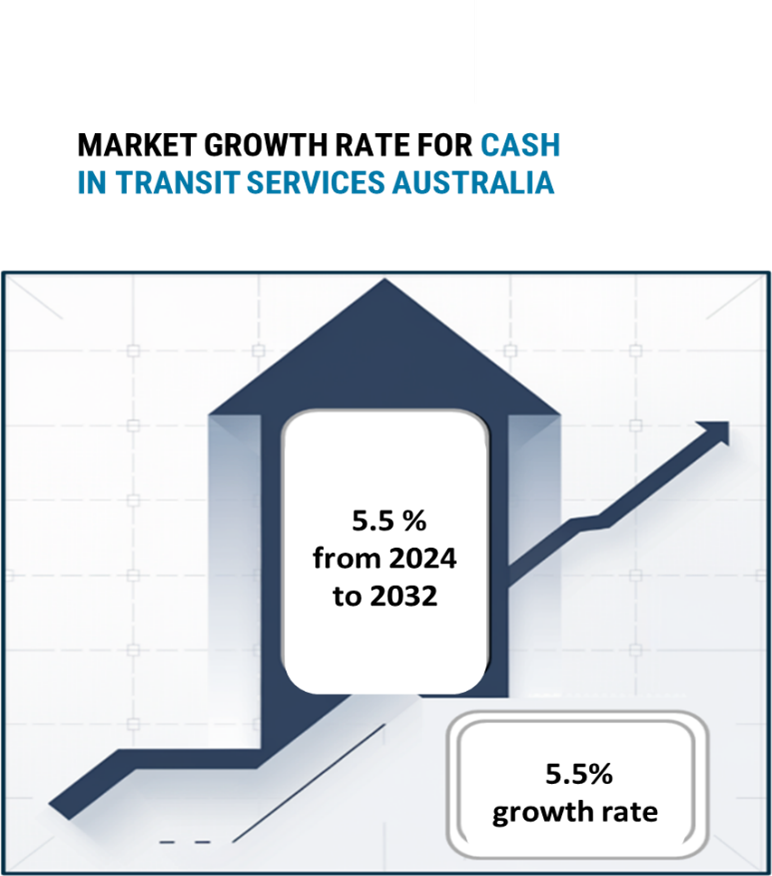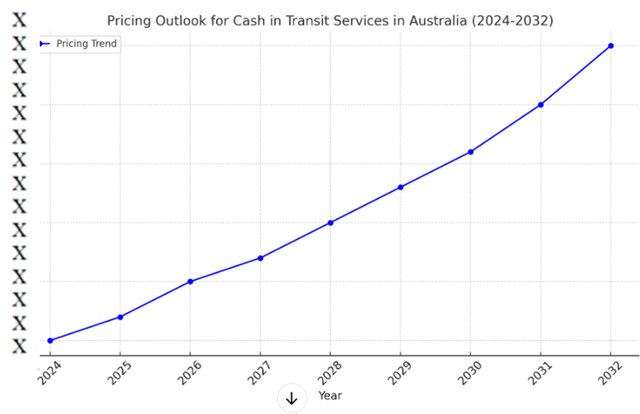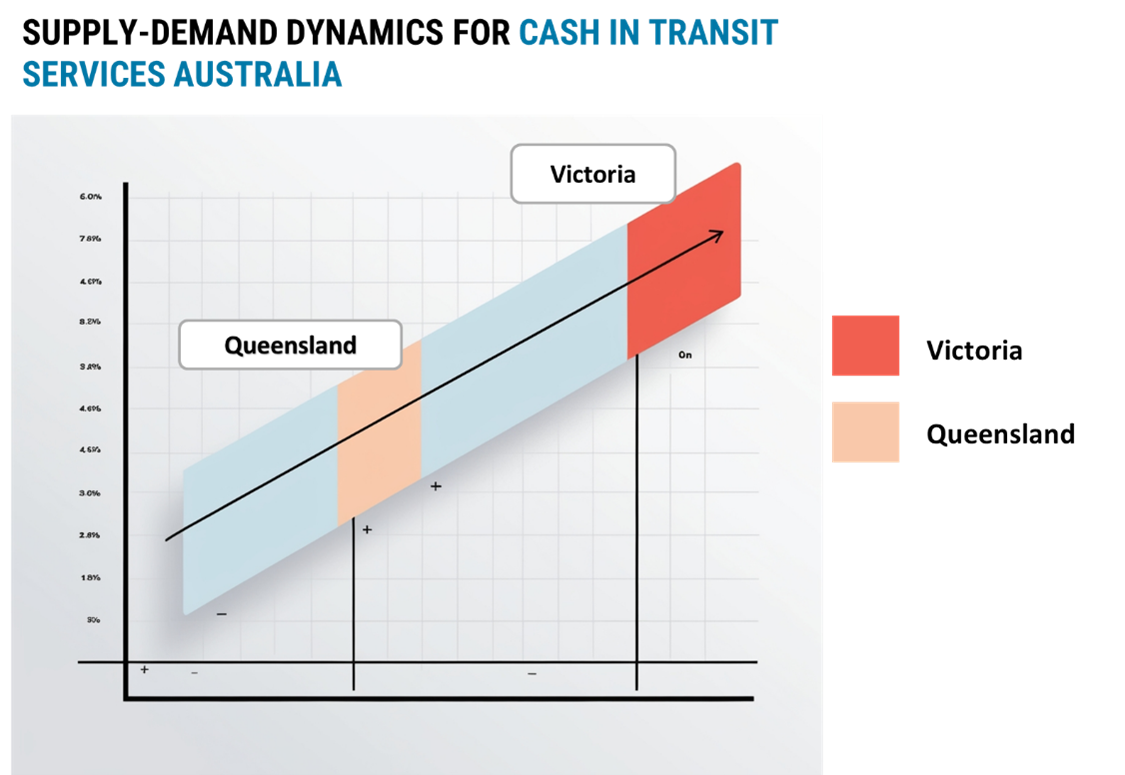Cash in Transit Services in Australia Market Overview:
The Australian Cash in Transit Services market is experiencing steady growth, driven by increased demand for secure cash handling and transportation, along with the rising need for advanced security solutions. This market covers various sectors, including retail, banking, and government services, and includes services like cash collection, transportation, and vaulting. Our report offers a comprehensive analysis of emerging procurement trends, focusing on cost-saving strategies through strategic partnerships, as well as the increasing adoption of digital tools to streamline cash management processes.
Future procurement challenges include the need for accurate demand forecasting and maintaining an efficient supply chain to ensure the timely delivery of cash and other financial services. Digital procurement solutions are expected to play a crucial role in enhancing the responsiveness and efficiency of CIT operations. Strategic sourcing and effective management of procurement processes are critical to optimizing service delivery and ensuring regulatory compliance in the evolving market landscape. As competition intensifies, market intelligence and procurement analytics are becoming essential to improving supply chain performance and maintaining a competitive advantage.
The outlook for the CIT services market in Australia remains positive, with strong growth projected through 2032, fuelled by several key factors:
- Market Size: The Australian CIT services market is expected to reach AUD 2.5 billion by 2032, growing at a CAGR of approximately 5.5% from 2024 to 2032.

Growth Rate: 5.5%
- Sector Contributions: Growth is primarily driven by:
- Retail and Banking Sectors: Increased demand for secure cash transportation in retail and banking industries, which require efficient, timely, and secure cash logistics.
- Regulatory Compliance: Rising regulatory demands for secure cash handling and transportation practices in line with national and international standards.
- Technological Transformation and Innovations: Advances in digital tools, GPS tracking, and automated cash management systems are enhancing the efficiency and security of CIT services, reducing operational costs and improving service accuracy.
- Investment Initiatives: Companies are investing in advanced technologies such as smart vaulting systems and digital tracking tools to improve security, enhance customer service, and reduce operational risks.
- Regional Insights: Major metropolitan areas in Australia are witnessing strong demand for CIT services due to the concentration of financial institutions and retail businesses. At the same time, regional areas are seeing growth due to the expansion of retail and banking networks.
Key Trends and Sustainability Outlook:
- Enhanced Digital Integration: The adoption of digital and automated tools for cash tracking and management is improving service accuracy and reducing the time required for cash handling operations.
- Advanced Security Solutions: Innovations in GPS tracking, surveillance technology, and secure transportation vehicles are strengthening the security of cash logistics and minimizing the risk of theft or loss.
- Focus on Sustainability: There is growing pressure to adopt sustainable practices in cash logistics, with companies focusing on reducing fuel consumption and minimizing the carbon footprint of transport vehicles.
- Demand for Customized Services: Businesses are increasingly seeking tailored CIT services that align with their specific cash handling needs and security requirements, as well as those that cater to local regulatory frameworks.
- Data-Driven Approaches: The increased use of data analytics is improving operational efficiency, enabling CIT service providers to optimize routes, reduce costs, and predict cash requirements more accurately.
Growth Drivers:
- Retail and Banking Growth: The expanding retail and banking sectors in Australia continue to drive demand for secure and efficient cash transportation services.
- Regulatory Standards: Stringent national and international regulations are fostering demand for certified, secure cash handling and transportation services.
- Technological Advancements: New innovations in cash logistics, such as real-time tracking systems and automated cash vaulting, are driving efficiency in the sector.
- Environmental Considerations: As sustainability becomes more important, CIT providers are adopting eco-friendly transport solutions to reduce their environmental impact.
- Tailored Solutions: The demand for customized CIT services is increasing as businesses seek more flexible solutions that meet their unique operational and security needs.
Overview of Market Intelligence Services for the Cash in Transit in Australia Services Market:
Recent reports indicate that the CIT services market in Australia faces challenges due to rising operational and security costs, primarily driven by the complexity of logistics and strict regulatory compliance requirements. Market intelligence reports provide insights into cost projections and highlight procurement opportunities that can help companies manage cost fluctuations while maintaining service quality. By leveraging these insights, stakeholders can adopt cost-saving strategies that improve procurement processes and ensure efficient service delivery, helping businesses stay competitive and compliant in a rapidly evolving market.
Procurement Intelligence for Cash in Transit Services in Australia: Category Management and Strategic Sourcing
To remain competitive in the Australian CIT services market, companies are refining their procurement strategies by using spend analysis tools to track vendor expenditures and enhance supply chain efficiency through market intelligence. Effective category management and strategic sourcing are key to achieving cost-effective procurement and ensuring the availability of critical resources required for secure cash handling services. Ensuring the timely delivery of services while maintaining high standards of security is crucial in a market where service reliability and compliance are paramount. By optimizing procurement processes, CIT service providers can manage costs, improve service efficiency, and maintain a strong position in the competitive landscape.

Pricing Outlook for Cash in Transit Services in Australia: Spend Analysis
The pricing outlook for Cash in Transit (CIT) services in Australia is expected to remain relatively stable, with occasional fluctuations driven by several key market dynamics. Changes in fuel costs, labor expenses, and investments in advanced security technologies are the primary factors influencing potential price variations. The demand for CIT services, especially from sectors such as banking, retail, and high-value asset transportation, plays a significant role in shaping pricing trends.
Graph shows general upward trend pricing for cash in transit services Australia and growing demand. However, there may be fluctuations influenced by economic conditions, technological advancements, and competitive dynamic.

Efforts to enhance operational efficiency, adopt modern technologies like GPS-enabled real-time tracking systems, and streamline logistical operations are pivotal in controlling service costs. The rising adoption of sustainable practices, including the use of energy-efficient vehicles and waste minimization strategies, is also helping to mitigate some price volatility.
Collaborating with reliable service providers, optimizing transport routes, and focusing on comprehensive security protocols are essential strategies for managing overall costs effectively. Despite challenges in the market, maintaining high-quality service standards, adhering to stringent safety regulations, and investing in workforce training remain critical to ensuring competitive pricing for Australian CIT services.
Cost Breakdown for Cash in Transit Services Australia: Total Cost of Ownership (TCO) and Cost-Saving Opportunities

- Fuel and Transportation Costs (35%)
- Description: The primary cost drivers in CIT services include fuel for armored vehicles, along with maintenance, depreciation, and operational expenses related to transportation. These costs fluctuate based on fuel price changes and the condition of the fleet.
- Trends: The increasing volatility in fuel prices is pushing CIT companies to adopt more energy-efficient vehicles, optimize transport routes, and invest in alternative fuel options. Innovations in vehicle tracking and smart route planning are helping reduce fuel consumption and operational costs.
- Labor (XX%)
- Regulatory Compliance and Insurance (XX%)
- Infrastructure & Overheads (XX%)
Cost-Saving Opportunities: Negotiation Levers and Purchasing Strategies for Cash in Transit Services
In the Australian Cash in Transit (CIT) sector, implementing efficient procurement strategies and improving operational practices can result in significant cost reductions and better service performance. Establishing long-term agreements with CIT providers, particularly for high-volume or recurring cash transportation needs within industries such as banking, retail, and high-value asset management, enables businesses to negotiate discounted pricing and favourable contract conditions. Volume-based contracts and enhanced payment terms further contribute to lowering costs per transaction.
Investing in cutting-edge security technologies, such as GPS-enabled tracking systems, biometric authentication, and real-time monitoring solutions, not only boosts security but also helps in reducing operational costs over time. Optimizing transportation routes through data-driven planning and adopting fuel-efficient or eco-friendly vehicles can significantly reduce logistics and fuel expenses. Companies can also consider diversifying their provider network to minimize supply chain risks, ensuring service continuity and competitive pricing in a dynamic market.

Supply and Demand Overview for Cash in Transit Services in Australia: Demand-Supply Dynamics and Buyer Intelligence for Effective Supplier Relationship Management (SRM)
The demand for CIT services in Australia continues to grow across sectors such as banking, retail, and high-value asset management, driven by increasing cash transaction volumes and stringent security requirements. Supply and demand dynamics in the CIT market are shaped by technological progress, regulatory compliance needs, and efforts to improve operational efficiency.
Demand Factors:
- Banking Sector: Sustained demand for secure cash handling and transport for retail and corporate banking clients is a key driver of growth for CIT services.
- Retail Sector: The rise in cash-based transactions and the need for regular cash replenishment make the retail industry a significant contributor to CIT service demand.
- High-Value Asset Management: The secure transportation of valuables, including gold, precious metals, and luxury items, is fuelling demand for specialized CIT services.
- Regulatory Compliance: Stricter regulations governing cash management, armoured transport, and surveillance systems are driving demand for high-quality CIT services that meet these standards.
Supply Factors:
- Technological Advancements: Innovations in tracking systems, advanced armoured vehicle designs, and secure communication technologies are enhancing the efficiency and safety of CIT operations.
- Security Infrastructure: The availability of modern fleets of armored vehicles and secure storage facilities plays a crucial role in maintaining uninterrupted CIT services.
- Geographic Expansion: The expansion of CIT providers into underserved and emerging regions strengthens supply chains and addresses the growing demand for secure cash handling.
- Service Provider Competition: Increased competition among CIT companies is improving service quality, ensuring competitive pricing, and driving operational efficiency, providing buyers with better and more secure options.
Regional Demand-Supply Outlook: Cash in Transit Services in Australia

The Image shows growing demand for cash in transit services Australia with potential price increases and increased Competition.
Australia: Dominance in Cash in Transit Services
Australia remains a prominent player in the Cash in Transit (CIT) services market, driven by a combination, including New South Wales, Victoria, and Queensland. Several key drivers contribute to the strong demand and supply of CIT services in Australia.
- Increasing Demand for Secure Cash Handling: With cash transactions still integral to sectors such as banking, retail, and high-value asset management, the demand for secure, reliable, and efficient CIT services continues to rise across the country.
- Advanced Security and Technology Infrastructure: Australia is equipped with a well-developed security infrastructure, including modern armored vehicles, real-time tracking systems, and cutting-edge surveillance technologies, ensuring safe and secure transport of cash and valuables.
- Stringent Regulatory Requirements: Australia has strict security and regulatory standards governing cash management, including compliance with regulations from entities like the Australian Prudential Regulation Authority (APRA) and the Reserve Bank of Australia (RBA).
- Innovative Service Methods: The Australian CIT market is advancing through the integration of innovative technologies such as automated cash processing systems, biometric authentication, and route optimization software.
Australia Remains a key hub cash in transit services Australia can price drivers Innovation and Growth.

Supplier Landscape: Supplier Negotiations and Strategies for Cash in Transit Services in Australia
The supplier landscape for Cash in Transit (CIT) services in Australia is highly competitive, with both global and regional providers driving the market's growth. These suppliers influence pricing structures, service quality, security technologies, and the availability of specialized CIT solutions. The market includes both large, established players that dominate the industry and smaller, regional companies that cater to niche markets, offering customized services for sectors like banking, retail, and high-value asset management.
The current CIT supplier landscape in Australia is shaped by strategic partnerships, technological innovation, and continuous service improvements. While leading global suppliers hold substantial market share, smaller regional players are gaining ground by focusing on specific customer needs and delivering tailored services that address varying security and operational requirements.
Key suppliers in the Cash in Transit services market in Australia include:
- Brinks Inc.
- G4S
- Loomis
- Prosegur
- Securitas AB
- ADT Security Services
- Allied Universal
- Diebold Nixdorf
- The CIT Group

Key Developments Procurement Category Significant Development:
|
Development |
Description |
|
Market Growth |
The Australian CIT services market is growing due to increasing demand from key sectors such as banking, retail, and high-value asset management. |
|
Sustainable Practices |
There is a rising trend in adopting environmentally friendly practices in cash transport, such as the use of energy-efficient vehicles and recycling initiatives. |
|
Service Diversification |
CIT services in Australia are becoming more diverse, offering tailored solutions for high-value assets, secure cash management, and electronic payment processing. |
|
Technological Innovations |
The integration of advanced security technologies like GPS tracking, real-time monitoring, and automated cash processing is improving the efficiency and safety of CIT services. |
|
E-commerce Expansion |
With the growth of e-commerce, the demand for secure cash handling services has increased, providing businesses with global access to reliable CIT solutions. |
|
Focus on Security Enhancement |
There is an increased focus on bolstering security measures, including the use of advanced armored vehicles, biometric authentication, and cutting-edge surveillance systems. |
|
Regional Expansion |
The expansion of CIT services into emerging regions within Australia, as well as the growing presence of global suppliers, is improving access to secure transport solutions and strengthening the supply chain. |
|
Cash in Transit Services in Australia Attribute/Metric |
Details |
|
Market Sizing |
The Australian Cash in Transit (CIT) services market is projected to grow steadily, with increasing demand from sectors like banking, retail, and asset management. |
|
Technology Cash in Transit Services in Australia Adoption Rate |
Around 45% of CIT service providers in Australia are integrating advanced technologies such as real-time tracking, GPS, and automated cash management systems to enhance service security and operational efficiency. |
|
Top Cash in Transit Services in Australia Services Strategies for 2024 |
Key strategies for Australian CIT services include focusing on improved security measures, adopting digital tools for enhanced tracking and route optimization, and expanding services in emerging regions. |
|
Process Cash in Transit Services in Australia Automation |
Approximately 35% of Australian CIT service providers are automating core operations such as cash processing, vehicle tracking, and customer management to boost efficiency and reduce operational costs. |
|
Cash in Transit Services in Australia Challenges |
Major challenges in the Australian CIT market include rising fuel prices, security concerns, regulatory compliance, and maintaining a secure and efficient supply chain for cash handling. |
|
Key Suppliers |
Leading CIT service providers in Australia include Brinks Inc., G4S, Loomis, and Prosegur, offering services to sectors such as banking, retail, and high-value asset management. |
|
Key Regions Covered |
Key regions in Australia benefiting from CIT services include New South Wales, Victoria, and Queensland, where demand for secure cash transport is strong, especially in banking and retail industries. |
|
Market Drivers and Trends |
The growth of the Australian CIT market is driven by the rising need for secure cash transport in the banking and retail sectors, the adoption of digital technologies, and innovations in cash management systems. |
Frequently Asked Questions (FAQ):
Our procurement intelligence services offer comprehensive market analysis to identify reliable CIT service providers in Australia, along with emerging trends in security and logistics. We provide spend analysis, supplier evaluations, and tailored sourcing strategies to secure cost-effective and secure cash transport solutions.
We assist in calculating the TCO for CIT services by considering factors such as transportation costs, security technology, labor costs, and risk management. Our insights help you understand the long-term financial impact of your procurement decisions for CIT services in Australia.
We offer risk management strategies to address challenges such as fuel price fluctuations, security risks, regulatory compliance, and potential supply chain disruptions. These strategies ensure continuous, secure, and reliable cash transport services while minimizing risks.
Our Supplier Relationship Management (SRM) services focus on building strong partnerships with Australian CIT service providers. We emphasize negotiation techniques, performance monitoring, and regular security audits to maintain a reliable and cost-effective cash transport service.
We recommend best practices such as supplier segmentation, cost benchmarking, demand forecasting, and establishing service level agreements (SLAs). These strategies help optimize procurement processes, ensuring reliable, efficient CIT services while generating cost savings.
Digital transformation improves CIT service sourcing in Australia through technologies like real-time tracking, automated cash management, and digital payment systems. These advancements increase operational efficiency, enhance security, and reduce costs while ensuring more effective service monitoring.
Supplier performance management is crucial for ensuring Australian CIT service providers meet key metrics such as punctuality, security standards, and regulatory compliance. This strengthens procurement decisions and ensures the reliable and secure transportation of cash.
We help refine your negotiation strategies by offering insights into the Australian market, comparing service provider pricing, and exploring opportunities for volume-based agreements or long-term contracts. This helps secure favourable terms and improves overall cost-efficiency.
Our market analysis tools provide valuable insights into Australian CIT demand, pricing fluctuations, regulatory developments, and competitor strategies. These tools support informed procurement decisions, ensuring your CIT services remain competitive and secure.
We ensure compliance by evaluating the certifications and regulatory adherence of CIT service providers in Australia. This includes meeting industry safety, security, and environmental standards, ensuring that your procurement practices align with local regulations.
Effective strategies to manage disruptions in Australia include diversifying service providers, creating contingency plans, and establishing backup solutions. These actions help mitigate risks and ensure a continuous, secure cash transport service during periods of instability.
Our supplier performance tracking tools monitor metrics such as delivery time, adherence to security protocols, and regulatory compliance. This data helps develop long-term procurement strategies and strengthens supplier relationships.
We help identify CIT service providers in Australia that prioritize sustainability through initiatives like reducing carbon emissions, optimizing fuel consumption, and using eco-friendly technologies. These practices align procurement with environmental and ethical standards.
Our pricing analysis services compare CIT service provider costs, evaluate market trends, and offer negotiation strategies to secure the best pricing. This ensures that you receive cost-effective, high-quality, and reliable CIT services for your business.








